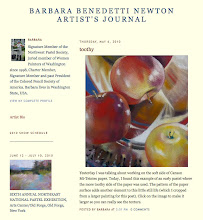Advice to myself that finally got me to about 80% complete on Percy Wiseman Rhododendrons, oil, 24 x 24 inches.
I’ve been an art instructor for more than 25 years and feel I give students excellent feedback on their work and possible changes for a successful outcome.
When I get stuck I talk to myself as if I am my student. I am kind but I cut to the chase. For this painting, the conversation went like this: Hmmmm…. ( I like to start with hmmm as if I have been thinking long and hard about the problem and have just discovered it, so it doesn’t appear to be obvious which in this case it was but I was in denial).
This painting started out as daffodils in one of my favorite vases. I set up the still life and took reference photos from slightly above the set up. After a couple days of blocking in I realized I had not corrected for the photo distortion even though I still had the real set up in front of me. Then I got busy and the flowers wilted and dried and I threw them out. Without the actual flowers I lost interest in correcting the composition so I began painting over that painting which was liberating and I posted an image on FB. After that post and before I went to bed, I took a big brush and painted over the flowers to create bigger shapes. Advice: I know you’re (I’m) excited to paint this but remember we first need big shapes that deal with value only. It was improved enough that I could fall asleep. But, in the middle of the night I realized the real problem.
Advice: I know you (I) really want to paint all the fun reflections in that vase but I think it is wrong for this painting for a couple reasons – the format is square and this vase and it’s delicate lines would work better in a vertical format unless you are willing to add enough supporting objects around it to support it as visual weight. Also, though these big fluffy flowers fit in the vase they can’t help but make it top-heavy which brings us back to supporting objects. Do you want supporting objects? No. So, lose the vase.
Now, once I change out the vase, the flowers are in a different position so I have to start all over again. Set it up, light it, take a color and gray photo and begin again. I already have lots of oil paint on my panel so I gave myself the advice to scrape most of the paint off panel. Now, begin again and this time I (instructor speaking) would work from the gray scale photo only. Look at the real-life set up for composition and placement but when applying value, look only at the gray scale photo. Paint value and shape. Do not paint color yet and do not say the word rhododendron. Say this shape, this light, this shadow, this play against that. Use a reducing glass if you get lost. Pay close attention to the values and shapes and do not fake them. You will be glad later that you were accurate at this point. There will be time for “artistic license” later. Also, go slow. Blah, blah, blah.
Take a progress photo. Walk away. Eat pasta. Go do something else for a balanced life.






Love the conclusion and the history behind this wonderful painting. Thanks for sharing your thought process!
ReplyDeleteI just discovered your blog (from the link on the photo of this beautiful painting on daily paintworks). I'm a new painter and I really enjoyed reading about your process. Thank you for sharing, your work is fabulous!!
ReplyDeleteWonderful notes! I laughed part way thru, since no pain for me, I'm just sitting here with a cup of tea. I've been there, perhaps why it was so easy to laugh.
ReplyDeleteLove what you are doing. I'm also in the midst of large value shapes and positive, joyful inner words. Love the process.